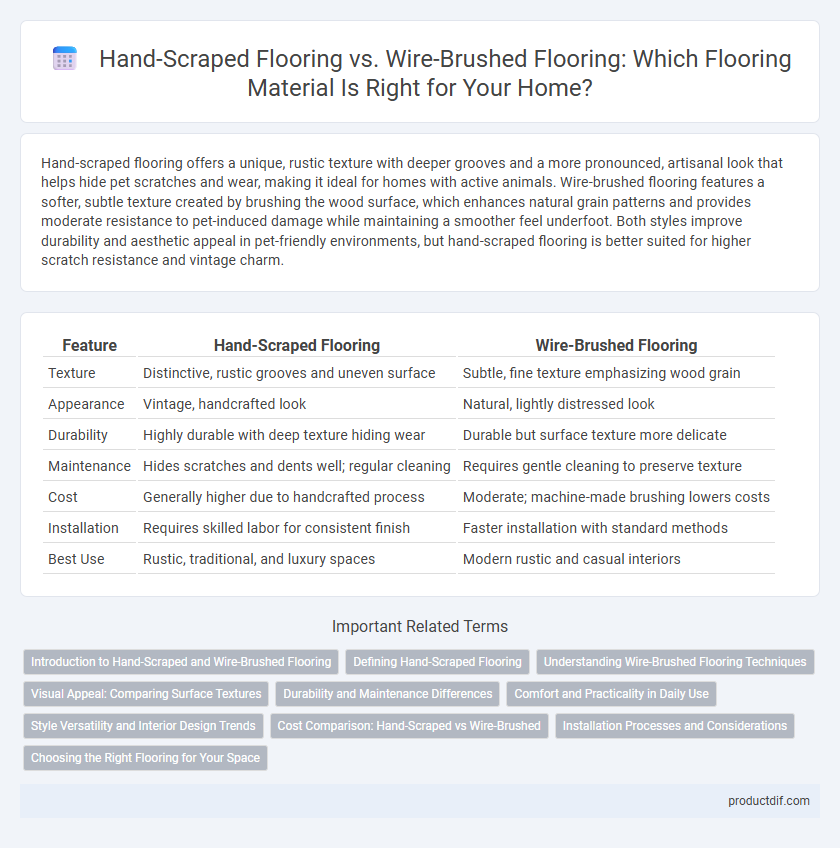Hand-scraped flooring offers a unique, rustic texture with deeper grooves and a more pronounced, artisanal look that helps hide pet scratches and wear, making it ideal for homes with active animals. Wire-brushed flooring features a softer, subtle texture created by brushing the wood surface, which enhances natural grain patterns and provides moderate resistance to pet-induced damage while maintaining a smoother feel underfoot. Both styles improve durability and aesthetic appeal in pet-friendly environments, but hand-scraped flooring is better suited for higher scratch resistance and vintage charm.
Table of Comparison
| Feature | Hand-Scraped Flooring | Wire-Brushed Flooring |
|---|---|---|
| Texture | Distinctive, rustic grooves and uneven surface | Subtle, fine texture emphasizing wood grain |
| Appearance | Vintage, handcrafted look | Natural, lightly distressed look |
| Durability | Highly durable with deep texture hiding wear | Durable but surface texture more delicate |
| Maintenance | Hides scratches and dents well; regular cleaning | Requires gentle cleaning to preserve texture |
| Cost | Generally higher due to handcrafted process | Moderate; machine-made brushing lowers costs |
| Installation | Requires skilled labor for consistent finish | Faster installation with standard methods |
| Best Use | Rustic, traditional, and luxury spaces | Modern rustic and casual interiors |
Introduction to Hand-Scraped and Wire-Brushed Flooring
Hand-scraped flooring features unique, textured grooves created by artisans to give each plank a rustic, aged appearance that enhances natural wood character. Wire-brushed flooring involves using stiff wire brushes to remove the soft wood grain, emphasizing the texture and grain patterns for a subtly distressed look. Both flooring styles offer durability and distinctive aesthetics ideal for adding warmth and character to residential and commercial spaces.
Defining Hand-Scraped Flooring
Hand-scraped flooring features a textured surface created by manually scraping the wood planks to mimic natural wear and antique charm. This process produces uneven grooves and a rustic appearance, enhancing the character of hardwood floors in traditional or farmhouse-style interiors. The distinctive hand-scraped finish offers durability and hides scratches better than smooth surfaces, making it a practical choice for high-traffic areas.
Understanding Wire-Brushed Flooring Techniques
Wire-brushed flooring techniques involve using stiff wire brushes to remove the soft wood grains, enhancing the natural texture and creating a subtle distressed look while preserving durability. This method accentuates the wood's grain patterns, making imperfections less visible and suitable for high-traffic areas, increasing the floor's lifespan. Compared to hand-scraped flooring, wire-brushed floors offer a more uniform surface with a rustic yet refined aesthetic, ideal for modern and traditional interior designs.
Visual Appeal: Comparing Surface Textures
Hand-scraped flooring features distinct, irregular grooves and indentations that create a rustic, aged appearance, emphasizing a handcrafted look ideal for traditional or farmhouse styles. Wire-brushed flooring exhibits a more uniform texture with subtle grain highlights, enhancing the natural wood pattern while providing a smoother surface suited for modern and transitional designs. Both textures enhance visual appeal, but hand-scraped offers pronounced character and depth, whereas wire-brushed delivers understated elegance with enhanced wood grain visibility.
Durability and Maintenance Differences
Hand-scraped flooring features deep grooves and a textured surface that better conceals scratches and dents, making it highly durable for high-traffic areas. Wire-brushed flooring has a softer texture with shallow grooves, which offers moderate durability but requires more frequent cleaning to prevent dirt buildup in the grain. Maintenance for hand-scraped flooring involves occasional refinishing to restore texture, while wire-brushed floors benefit from regular sweeping and gentle mopping to preserve their subtle details.
Comfort and Practicality in Daily Use
Hand-scraped flooring offers a textured surface that provides natural grip and warmth, enhancing comfort underfoot, while wire-brushed flooring features a softer, more uniform texture that is easier to clean and maintain in everyday environments. The irregular grooves of hand-scraped floors can trap dust, requiring more frequent maintenance, whereas wire-brushed finishes resist dirt accumulation and withstand heavy foot traffic. Both options deliver durability, but wire-brushed flooring is often preferred in high-traffic areas for its practicality and ease of upkeep.
Style Versatility and Interior Design Trends
Hand-scraped flooring offers a rustic, textured appearance that enhances traditional and farmhouse interior design trends, creating a warm, inviting atmosphere with unique character variations. Wire-brushed flooring features subtle grain emphasis and a more contemporary, sophisticated look that aligns with modern, industrial, and transitional styles, emphasizing understated elegance. Both finishes provide style versatility, but hand-scraped textures suit cozy, vintage-inspired spaces while wire-brushed surfaces complement sleek, minimalist interiors.
Cost Comparison: Hand-Scraped vs Wire-Brushed
Hand-scraped flooring typically costs between $8 and $12 per square foot due to the labor-intensive craftsmanship involved, while wire-brushed flooring ranges from $5 to $9 per square foot, reflecting its less intricate finishing process. The higher installation and maintenance expenses associated with hand-scraped floors contribute to the overall increased investment compared to wire-brushed options. Budget considerations often lead homeowners to choose wire-brushed flooring for a more affordable yet durable textured surface.
Installation Processes and Considerations
Hand-scraped flooring requires careful alignment of planks to maintain the natural, distressed look, demanding precise installation techniques to prevent gaps and ensure a seamless finish. Wire-brushed flooring involves brushing the wood grain to remove soft fibers, making it easier to install due to its smoother and more consistent surface, but still requires appropriate acclimation to avoid expansion or contraction post-installation. Both methods benefit from professional-grade adhesives and moisture barriers to enhance durability and stability on various subfloors.
Choosing the Right Flooring for Your Space
Hand-scraped flooring offers a rustic, textured surface created by manually distressing the wood, ideal for adding character and warmth to traditional or farmhouse-style interiors. Wire-brushed flooring features a lightly abraded surface that highlights the wood grain while providing a subtle, modern texture suited for contemporary and high-traffic areas. Selecting the right flooring depends on your desired aesthetic, durability needs, and maintenance preferences, with hand-scraped flooring favoring a timeless, handcrafted look and wire-brushed flooring enhancing natural grain visibility and scratch resistance.
Hand-Scraped Flooring vs Wire-Brushed Flooring Infographic

 productdif.com
productdif.com